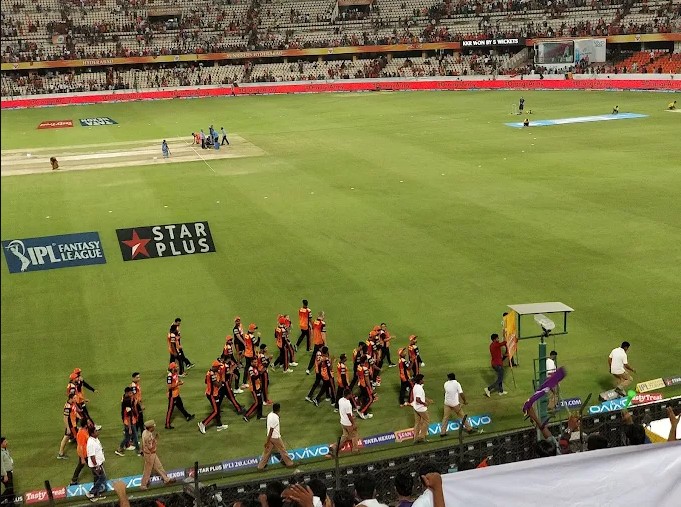Rajiv Gandhi Stadium: Cricket grounds play a significant role in shaping match outcomes, especially in terms of pitch behavior and boundary sizes. One such prominent venue in India is the Rajiv Gandhi International Cricket Stadium, located in Uppal, Hyderabad. Home to the Sunrisers Hyderabad in the Indian Premier League (IPL) and the Hyderabad Cricket Association, this stadium has hosted several international and domestic matches since its inauguration.
Table of Contents
Overview of the Stadium
| Feature | Specification |
|---|---|
| Full Name | Rajiv Gandhi International Cricket Stadium |
| Location | Uppal, Hyderabad, Telangana, India |
| Established | 2005 |
| Seating Capacity | ~55,000 |
| Home Teams | India (International), Sunrisers Hyderabad (IPL), Hyderabad (Domestic) |
| Pitch Type | Balanced (slightly spin-friendly at times) |
| Ends | Pavilion End, North End |
Importance of Boundary Lengths
Boundary size plays a vital role in a cricket match by impacting scoring rates, bowler strategies, and even crowd excitement. Larger boundaries generally help bowlers contain big hitters, while smaller boundaries contribute to high-scoring thrillers.
Boundary Dimensions at Rajiv Gandhi Stadium
The boundary lengths at Rajiv Gandhi Stadium can vary slightly depending on the match setup and pitch position. However, here are the general dimensions based on standard placements:
Average Boundary Lengths at Rajiv Gandhi Stadium
| Direction | Distance (Approximate) |
|---|---|
| Straight | 70-72 meters |
| Square | 65-67 meters |
| Midwicket | 68-70 meters |
| Cover | 66-68 meters |
| Fine Leg | 62-64 meters |
| Third Man | 62-64 meters |
These dimensions are moderate compared to other major international stadiums in India. For example, Eden Gardens in Kolkata features slightly shorter square boundaries, while Ahmedabad’s Narendra Modi Stadium has some of the longest straight boundaries in the country.
Impact on Batting and Bowling
The boundary lengths at Rajiv Gandhi Stadium influence playing strategies in several ways:
For Batters
- Shot Selection: The 70+ meter straight boundaries challenge batters to time their lofted shots well.
- Preferred Zones: Many batters prefer the square and midwicket regions, which offer better scoring opportunities due to marginally shorter lengths.
- Right vs Left-Handed Advantage: Depending on the pitch and boundary alignment, either left or right-handed batters may find more favorable hitting angles.
For Bowlers
- Spinners: Tend to benefit from the larger boundaries, especially when the pitch offers turn. The length allows more margin for error with flighted deliveries.
- Pace Bowlers: Often target the longer side for short-pitched deliveries to force mistimed shots.
Stadium Records and Boundary Influence
The stadium has hosted numerous thrilling games where boundary dimensions have played a pivotal role. Below is a table highlighting notable high-scoring matches:
High-Scoring Matches at Rajiv Gandhi Stadium
| Match | Total Score | Match Type | Outcome |
|---|---|---|---|
| India vs West Indies (2018) | 323/2 (India) | ODI | India won |
| Sunrisers vs RCB (2019) | 231/2 (SRH) | IPL | SRH won |
| Sunrisers vs KKR (2023) | 205/3 (KKR) | IPL | KKR won |
Comparisons with Other Indian Stadiums
Boundary Comparison with Other Stadiums
| Stadium | Straight (m) | Square (m) | Notes |
|---|---|---|---|
| Wankhede, Mumbai | 68 | 63 | Known for short boundaries |
| Eden Gardens, Kolkata | 67 | 61 | Smaller square boundaries |
| Narendra Modi, Ahmedabad | 75 | 70 | Largest cricket stadium in world |
| M. Chinnaswamy, Bengaluru | 65 | 60 | Very short; paradise for hitters |
| Rajiv Gandhi, Hyderabad | 70-72 | 65-67 | Moderate, balanced dimensions |
Boundary Behavior in IPL vs International Matches
Interestingly, boundary sizes are sometimes slightly adjusted during IPL matches for broadcast and camera positioning. The IPL matches at Hyderabad often see boundary ropes pulled in by 2 to 3 meters, especially on square boundaries, to allow for advertising boards and to encourage higher scores for viewership appeal.
In contrast, international fixtures generally follow ICC guidelines more strictly, ensuring a minimum boundary length of 65 meters in every direction.
Technological Insights and Player Strategies
Many modern players use stadium analytics software that includes heatmaps and average boundary clearances. For instance:
- Power hitters like Nicholas Pooran and Glenn Maxwell target midwicket and long-on due to the slight difference in length.
- Spinners like Rashid Khan and Kuldeep Yadav benefit from longer square boundaries, bowling wider lines to induce mistimed cuts and pulls.
Fan Experience and Stadium Design
From the fans’ perspective, the moderate boundary sizes offer the perfect blend of six-hitting entertainment and bowling finesse. The stands are built close enough to give fans a clear view of the ball soaring over the ropes, while also appreciating fielding efforts near the boundary line.
The Rajiv Gandhi International Cricket Stadium offers a balanced cricketing arena. Its boundary lengths—neither too short to be a graveyard for bowlers nor too long to curb batting excitement—strike the perfect middle ground. As a result, it has produced memorable matches across formats and continues to be a critical venue in India’s cricketing map.
Quick Recap Table
| Key Attribute | Value |
|---|---|
| Average Straight Boundary | 70-72 meters |
| Average Square Boundary | 65-67 meters |
| Suits which players | Balanced for both batters & bowlers |
| Most Memorable IPL Knock | David Warner’s centuries for SRH |
| Pitch Behavior | Balanced, some spin support |

